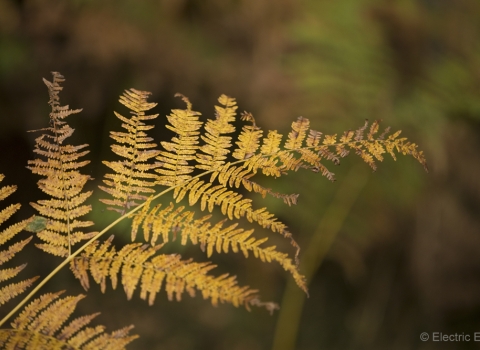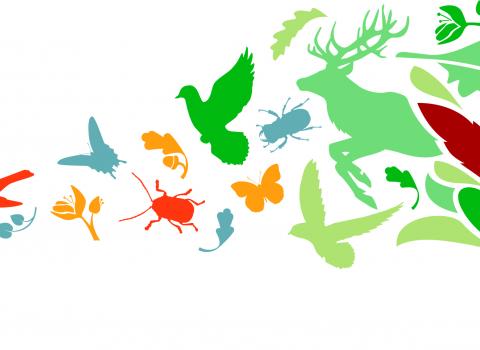
Imagine...
Our vision for the Sherwood Forest Heathlands Living Landscape area is to recreate the once extensive and interconnected heathlands, woodlands and wood pasture landscapes of Sherwood.
In this way, in 20 years time, the once great heathlands and oak forests that linked Nottingham to Worksop will be reconnected, with the song of the woodlark and the churring of nightjar heard throughout its extent and where views of brown argus butterflies, green tiger beetles, lizards and red deer are common.
This will be a landscape where farming, conservation and sustainable tourism can work together for a shared vision that benefits all and provides an inspirational environment for people to live and work.
Our goal
To reconnect and enhance Sherwood’s ancient heathland habitats through the implementation of landscape-scale, multi-partner conservation initiatives, and by reconnecting local communities to their landscape. This will support more robust populations of scarce species.
Habitats and species
Lowland Heathland is an internationally rare and threatened habitat, identified as a priority under European law. The key biodiversity action plan habitats in Sherwood are:
- Lowland Heath
- Acid grassland
- Oak-birch woodland (low land broad leaved woodland)
- Mesotrophic standing waters
- Rivers and streams
- Wood pasture
- Marsh
Many priority species (and characteristic but declining species in Notts) are present in Sherwood, but in substantially lower numbers than at the turn of the last century. We hope to conserve and increase their populations so that they are more able to withstand external pressures, such as from climate change. These include:
- Nightjar
- Woodlark
- Leisler's bat
- Adder
- GCN, range of invertebrates including Common Lizard
- Water voles
- Common toad
- Hazel pot and green tiger beetles
- Saproxylic invertebrates of ancient oaks
- A range of moths including large red-belted clear-wing moth and emperor moth
Partnership
It is very important that we work in close partnership with the farming community and local residents so that there is widespread engagement and support for the work.
Location
Background
Britain has lost 75% of its Heathland since the early 1800’s but still supports 15% of the total European Lowland Heathland. The project is of international importance.
Nottinghamshire's heathlands are particularly important. They represent the structurally diverse Midlands heaths, which differ in character from the southern heaths and have a much more limited distribution. They've also sustained huge losses to intensive agriculture, mining and development. Characteristic Nottinghamshire sandland heaths are a complex mosaic of heathland, acid grassland, oak-birch woodland and small, often ephemeral, wetlands.
The Heathland Inventory shows the limited distribution of the Midlands heaths and the importance of those in Nottinghamshire, including the only National Nature Reserve in the county. Surveys for nightjar and woodlark have shown the national importance of our heaths for these species. Sherwood is a very important area for herptiles in the County and scarce moths and bats (inc Liesler’s bat, an uncommon speicies).
There is a serious problem with illegal off-road vehicle activity in this area, which is damaging many of the heaths.
- Former coalfield community-high levels of social and economic disadvantage.
- Mansfield ranked as 37th amongst the 100 most deprived local authorities in England and the Crime and Disorder Reduction Partnership is categorised as “very high crime”.
What is happening now?
This scheme is a long-term initiative of regional importance. The aim is to restore the lost extent of Sherwood’s ancient heathland and continue the story of the developing Sherwood landscape. The traditional heathland and acid grassland habitats were eroded in the 1900’s through intensification of agriculture, commercial forestry, coal mining and quarrying for sand.
This project will recreate these habitats through the conservation development of sites that once contributed to its destruction. Developing and connecting these areas is vitally important, providing nationally important habitats for priority species. There are also key benefits to local people, connecting them with the landscape from which their community has grown.
The Rainworth and Rufford Heaths Project
The project seeks to bring together several key sites (including over 200 hectares already in partners’ ownership), which constitute the wider “Rainworth and Rufford Heaths Project Area”. These include:
Rainworth Heath and Strawberry Hill Heath SSSIs
(40 hectares), which constitute some of the few remaining relics of high quality lowland heathland, and only surviving wet heath, in the county.
Rainworth Water Local Nature Reserve (Rufford Old Pit Tip)
A large, former pit tip site restored to a mixture of agricultural grassland, acid grassland (44 hectares) and mixed plantation woodland (16 hectares). Rainworth Water runs through the centre of the site in a deep valley, dominated by wet woodland (mainly Willow and Alder) with areas of adjacent marshy grassland.
Rufford Colliery Complex
Working with Harworth Group on the former Rufford Colliery Complex to create and restore an area of restored lowland heath and acid grassland of 109 hectares (Rufford Main Tip); restore the former stocking area and landfill site; and bring existing habitats into good management.
Living Landscape Vision for Sherwood
In order to deliver our Living Landscape Vision for Sherwood we are currently:
What we are doing
- Providing farm conservation advice; helping farmers with agri-environment applications and providing training to farmers on wetland and water management, through our catchment hosting role for the Idle (which includes the Meden, Maun, Poulter and Rainworth Water);
- Working closely with individuals including landowners, local authorities and industrial representatives, particularly from the mineral Industry, to develop relationships and identify opportunities for habitat gain;
- Working with policy makers and the statutory agencies to ensure that strategic plans incorporate a biodiversity gain in their core principles;
- Working with our partner organisations to deliver biodiversity projects, such as habitat enhancement for key species such as nightjar, woodlark and water voles;
- Undertaking heathland creation, removing areas of pine and gorse and reseeding with local origin material;
- Undertaking a programme of environmental education work from Portland Park
- Managing our reserves in the area to optimise biodiversity gain;
- Engaging local residents and visitors to the area with their local environment, through walks, talks, involving people in surveying for wildlife and visits to Reserves;
- Working through the available tools, such as the Catchment Management Plans, to find ways to enhance the biodiversity of the Valleys;
- Bringing farms into our Bed & Breakfast for Farmland Birds Scheme, to encourage the conservation of farmland birds that have declined over the last few decades, such as tree sparrow, grey partridge, yellowhammer and linnet;.
- Facilitating enhanced conservation land management through investigating ways of reintroducing conservation grazing to the area;
- Undertaking riparian habitat improvements and the creation of small wetlands;
- Undertaking surveys and monitoring to establish effectiveness and inform future direction;
- Protecting the reserves and visitors through installation of improved fencing and the use of ditches where necessary to create a barrier preventing illegal access from motorcycles;
- Enhancing community engagement through events to encourage access and understanding of the wildlife;
- Providing interpretation materials to enable the community to understand the story of the developing landscape;
- Establishing 'friends groups' that will provide sustainable management increasing the communities’ sense of ownership. Volunteer opportunities and associated training will assist in the project’s overall objectives. Volunteeringwill also enable and promote the development of new skills, increased sense of achievement and physical wellbeing;
- Undertake creation of characteristic Sherwood oak-birch woodland and acid grassland from previous arable land; and
- Undertake conversion of species-poor agricultural grassland to heathland and acid grassland.
What does this mean for the future?
This project is an important step in securing the future robustness of heathland habitat in Nottinghamshire, particularly given the threat from climate change, and will make a significant contribution to the long term ambition of creating a living landscape across Sherwood, re-connecting areas of fragmented heathland, creating new heathland and woodland and an improved access network for the community.
Priority species
Many priority species (and characteristic but declining species in Notts) are present in Sherwood, but in substantially lower numbers than at the turn of the last century, we hope to conserve and increase their populations so that they are more able to withstand external pressures, such as from climate change, in the future, these include:
Nightjar
secure current population and increase by 3 pairs
Woodlark
secure current population and increase by 5 pairs
We will also establish good baseline data and secure and conserve current populations as a minimum for Leisler’s bat and adders species.







